Tennessee Field Diamonds
6
A treasure 485
million years in the
making.
|
Quartz crystal
morphology
What stories
can they tell?
What,
if anything, can we say about these crystals?
First,
it seems that the ones in the Knox Group formations have
greater variety. There’s always both elongate
prismatic crystals and bipyramidal crystals, and
everything in between. Transitional forms,
so-called “scepters”, are most commonly clear
bipyramidal quartz growing over milky fractured prismatic
quartz are common. With the one exception, the
occurrence near the Great Smoky Fault at Walland, no
Sevier Shale crystals are strongly prismatic, and few
show scepter overgrowth formation. So can we
organize and interpret this to see if any conclusions can
be drawn?
We
will also go far afield in an attempt to place
"Herkimer" type doubly terminated crystals into
the enormous variety of quartz morphology seen in nature.
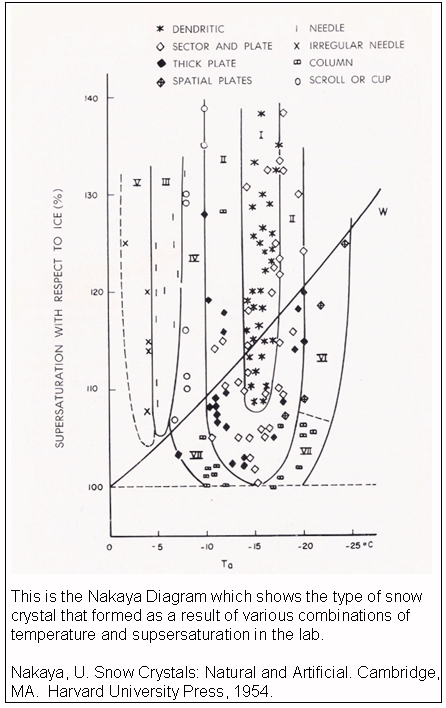
This is the Nakaya Diagram, presenting experimental
results from the first experiments to grow snow crystals,
and partly the inspiration for this project. It
shows crystal morphology plotted against temperature and
degree of supersaturation, and shows a “sweet
spot” of conditions where dendritic
“classical” type snow crystals form. I
wondered if anyone had done the same thing for quartz.
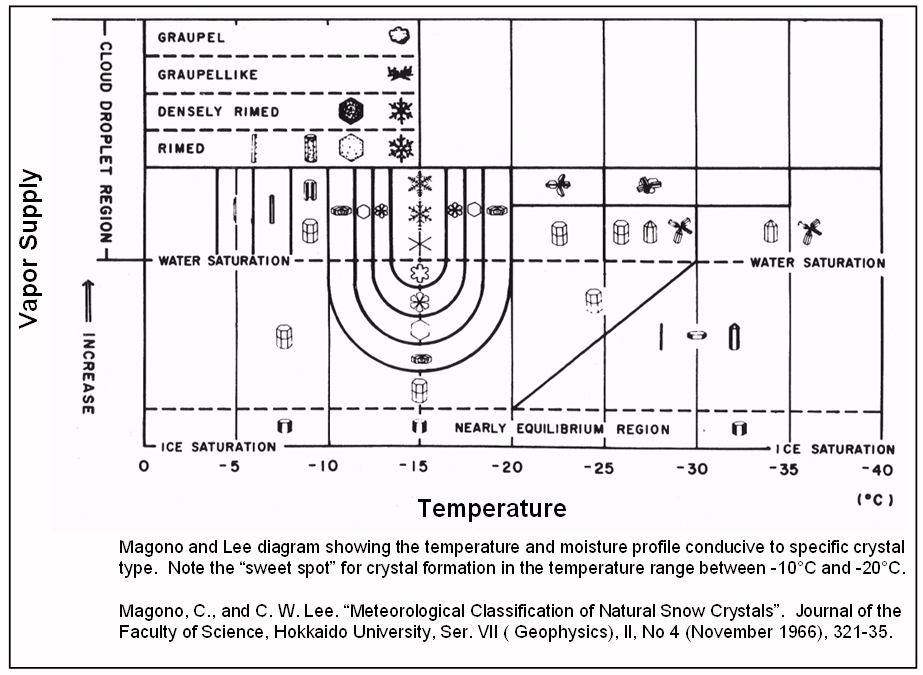
This diagram from Magono and Lee applied the Nakaya
Diagram to natural snow.
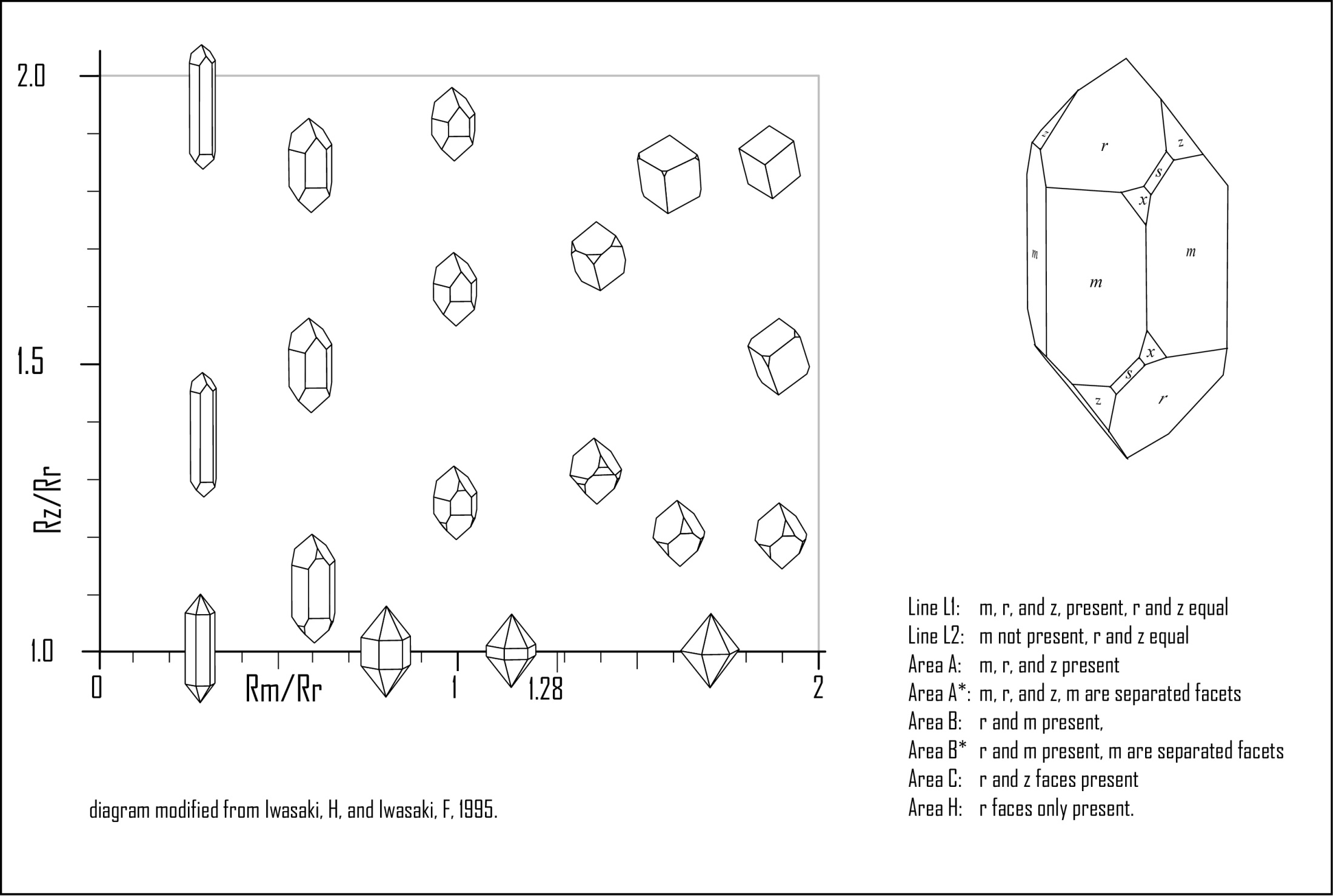
The closest thing is a plot of morphology, referred to as
a “morphodrom” done by Iwasaki and
Iwasaki. Quartz deposition on the prismatic faces
increases to the right, and the relative development of
the two sets of pyramidal (rhombohedral) faces up and
down.
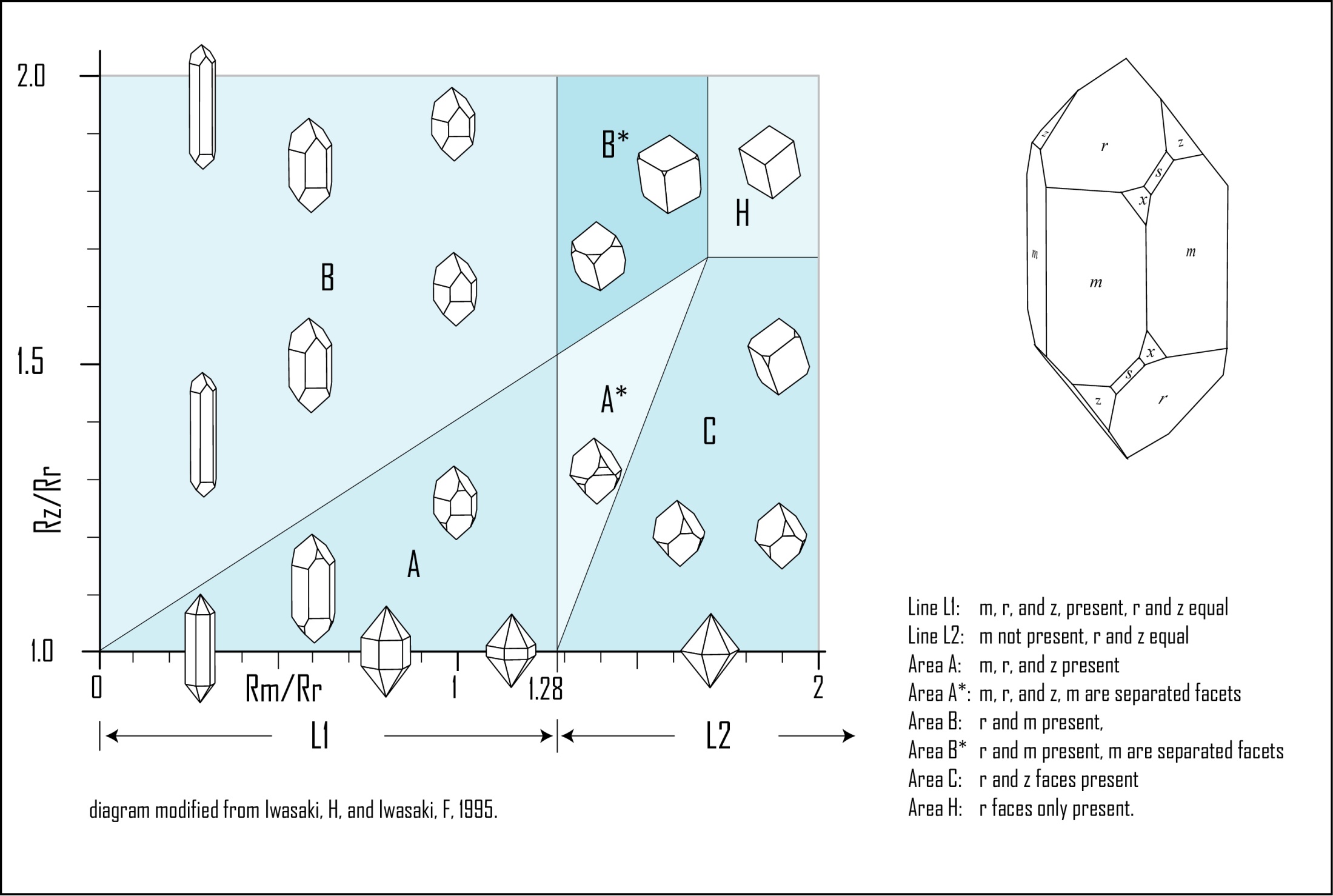
Fields are defined by the presence of specific faces and
their relations. It is important to consider that a
crystal is defined by its slowest-growing faces.
For example the relative growth rate of the prismatic
“m” faces increases going to the
right – they grow themselves out of existence.
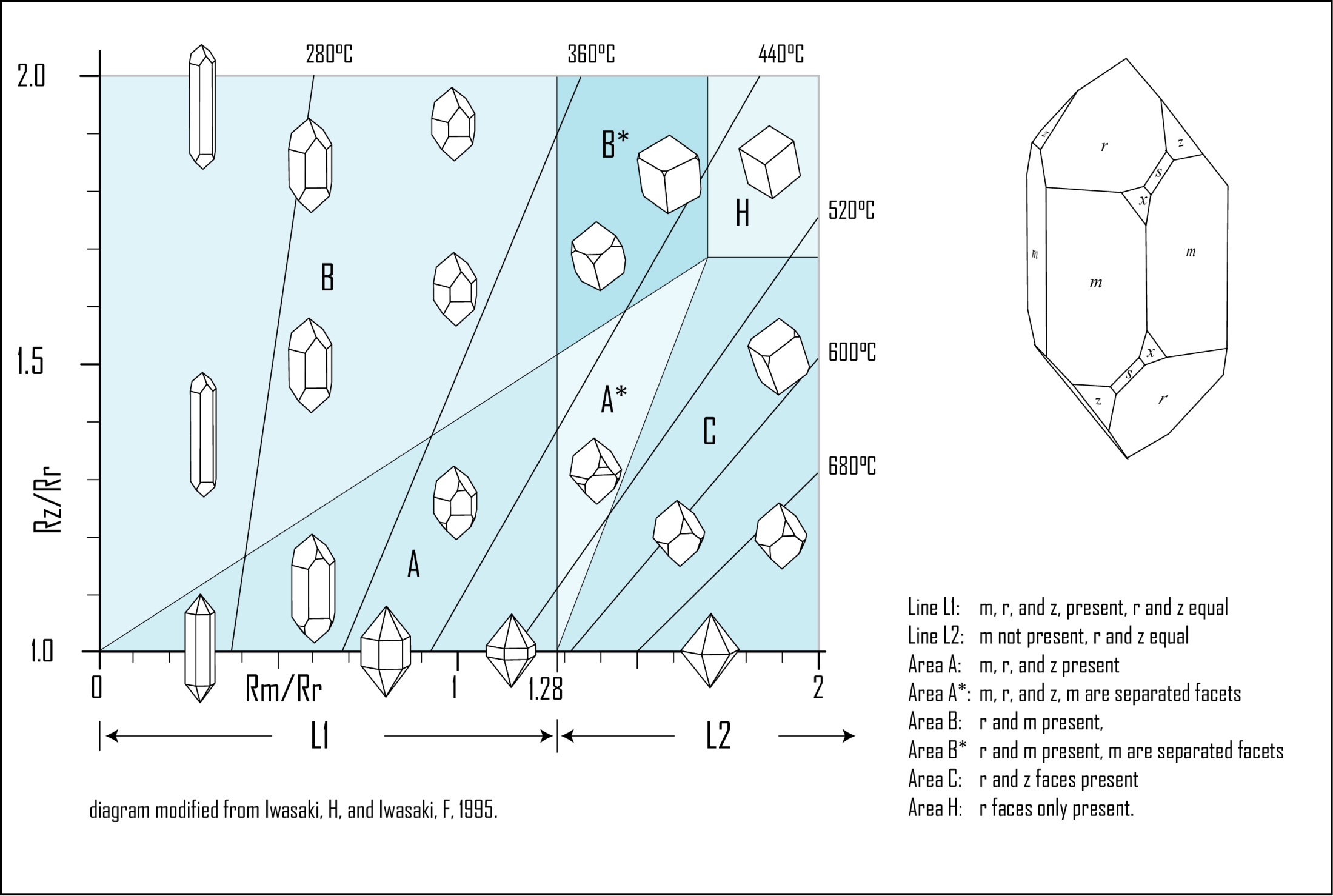
Here are his isotherm lines. I’m not clear
what he based them on, but if he is correct, then we
could say that the earlier stages where we find the
longer prismatic crystals are generally cooler, and the
later stages of quartz deposition and overgrowths; the
scepters and the bipyramidal crystals from the Sevier
Shale, took place at higher temperatures. A
“path” showing change in morphology over time
can be defined. The problem is that a fluid
inclusion analysis for a quartz crystal at Douglas Dam
reported by Edwin Roedder showed much lower
temperatures. Unfortunately, he did not say whether
they were looking at an early prismatic crystal or a late
bipyramidal crystal. The interpretation is questionable,
particularly since bipyramidal crystals occur in
concretions in northern Ohio, far from any orogenic
disturbance. Also, conodont alteration
indices for these rocks do not suggest anything nearly as
hot as suggested by their isotherms.

Time line, with crystal morphologies, showing possible
paragenetic timing. The actual truth is probably
more complex, as the crystals at Douglas dam show
evidence of a stage of “reverse scepter” or
long prismatic over stubby prismatic, growth. Also,
crystal formation is likely concentrated nearer the
period just before, during, and after the Alleghenian
Orogeny.
Post-crystallization
History
What further stories can they tell?
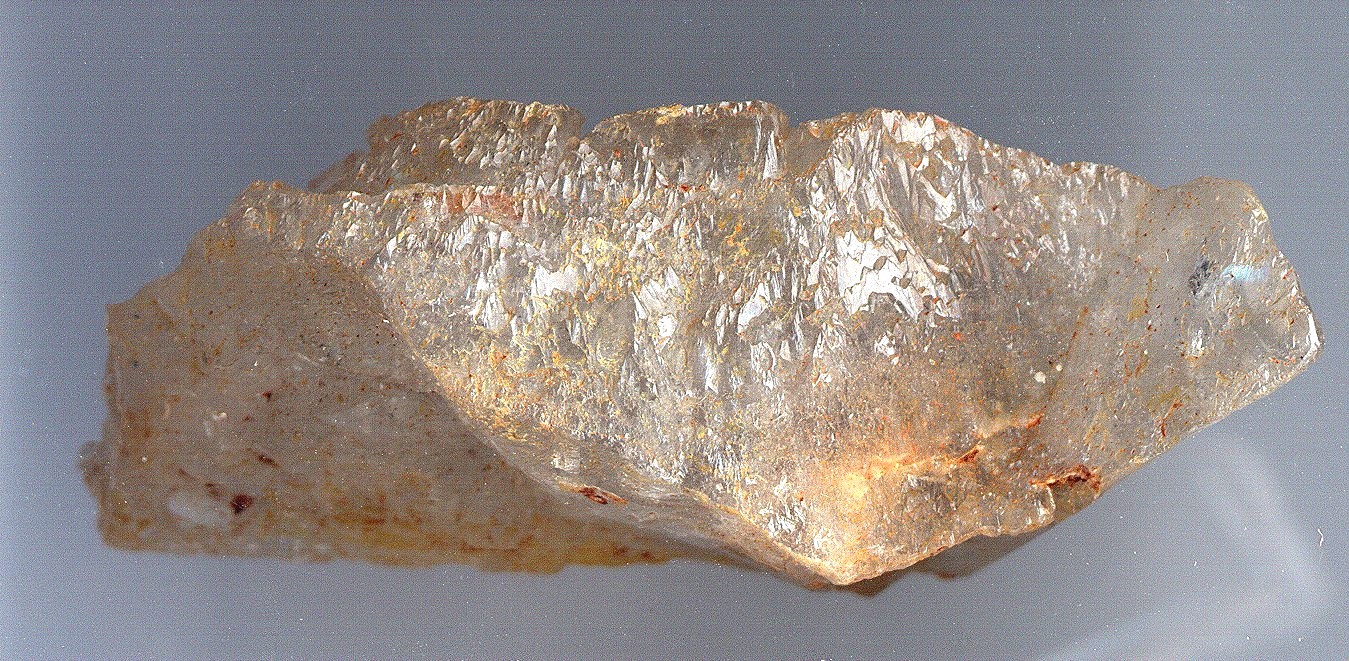
Regrowth: Large quartz crystal
fragment from Douglas Dam showing regrowth after
cracking. This suggests that the crystals were
present before the end of the orogenic event. I
have not encountered Sevier Shale crystals showing
evidence of regrowth.
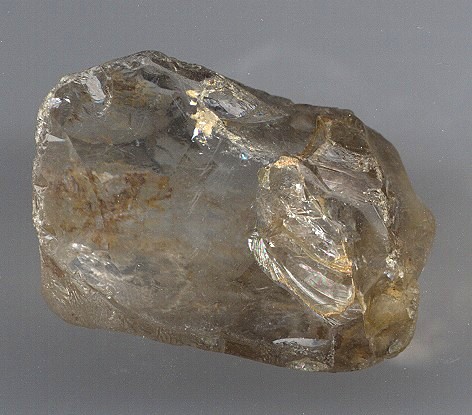
Transport: In most places, most
crystals are completely unworn, which suggests that they
come from the nearby bedrock, and have not been moved
about by water. But in many places where you find
crystals, some of them ARE water-worn. This is somewhat
of a mystery, especially since I have never encountered a
water-worn crystal in areas where they are not otherwise
found very nearby. It’s like they show
evidence of being transported without being moved long
distances. One exception is Diamond Creek, across
the river from White Pine. Here, all the crystals show
some degree or erosion and tumbling. These occur in
stream gravels in and adjacent to the creek where its
course is exposed in the lake bed. The creek’s
watershed is entirely in the Sevier Shale. The
large crystal fragment above is from Diamond Creek.
Most of these show abrasion from impact
under fairly violent conditions, consistent with the
larges sandstone cobbles in the creek and adjacent
alluvium, including the creek bed well away from the rive
and present-day lake bed. The cobbles appear to be
sourced from the Chillhowie Group and Thunderhead
Mountain exposures from the higher ridges and mountains
to the east. I have not explored the immediate area, but
similar gravels are often found on the lower ridgetops,
deposited when rhe rivers ran at higher levels.

This is about the minimum degree of wear seen on
these crystals. Right click and open in new tab
for detail. |
|

Impact abrasion, predominantly on edges and
corners is typical at Diamond Creek. |
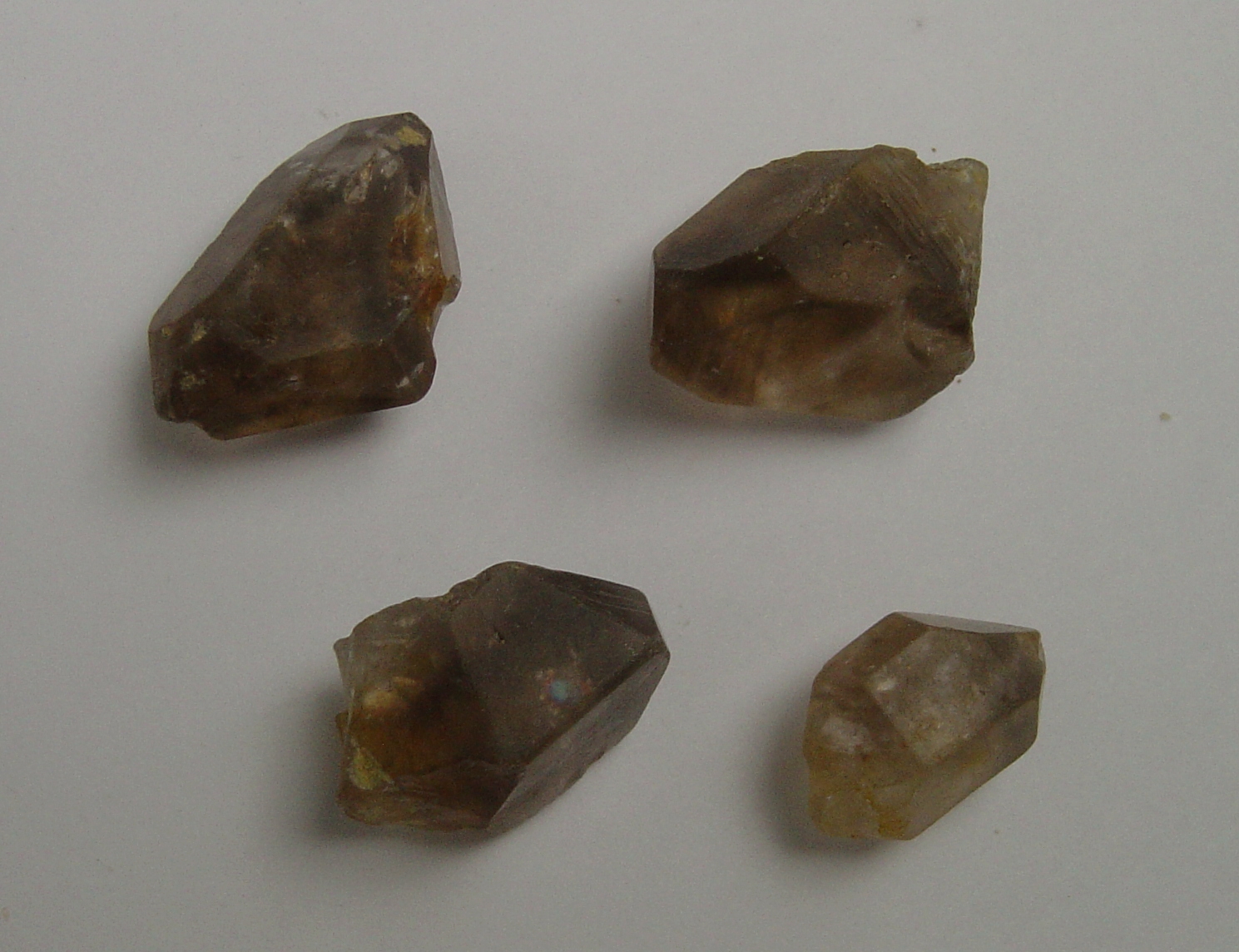
Abrasion: On the other hand, crystals
from Muddy Creek sometimes show scratched and eroded
faces. Wear is less concentrated on the edges and corners
as on the Diamond Creek specimens, and its appearance is
different. Perhaps they were lying in the soil for
several millennia, where animals stepped on them from
time to time.
 . . . . 
Scratches, almost as much on faces as corners and edges.
Right click and open in new tab for enlarrged images.
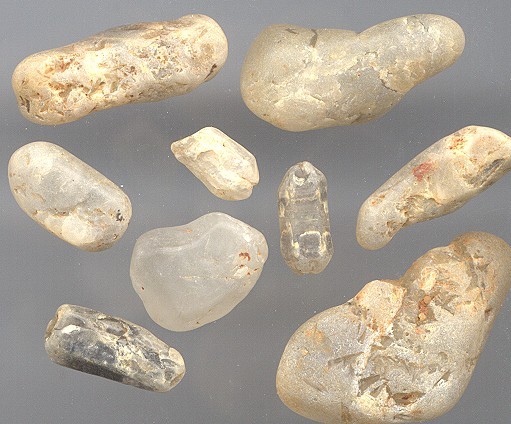
Milling: At Douglas Dam, small
concentrations of water-worn crystals are found in the
residual clay. They were ssimilar to the local unworn
specimens, complete with black inclusions. How
could it be that crystals that appear transported are
concentrated so near similar fresh ones? An
explanation might involve some kind of in-place milling
action in a restricted cavity caused by groundwater
flow. In the East Tennessee zinc mines they have
found fragments of zinc ore in vugs that are rounded and
eroded, and that is the explanation given for those
occurrences.
“Herkimer” type crystals
and other varieties of quartz
growing into open space:
Do “Herkimers” fit into a
bigger picture?

Classification diagram, more of a doodle. The
horizontal axis is whether the quartz is
cryptocrystalline or macrocrystalline, and the vertical
axis is whether the quartz tends to cover all surfaces or
just grow on existing quartz.
Here,
“drusy quartz” refers to when quartz crystals
cover all surfaces, even where the crystals have grown
large as in a Brazilian amethyst geode. In drusy
quartz, crystals start out small and numerous, and grow
competitively, generally along the C axis, so that with
time there are fewer larger crystals with single
terminations. Doubly terminated crystals are rare.
In true chalcedonic agate, the crystals are elongated not
along the C axis, and grow along one of the perpendicular
axes.
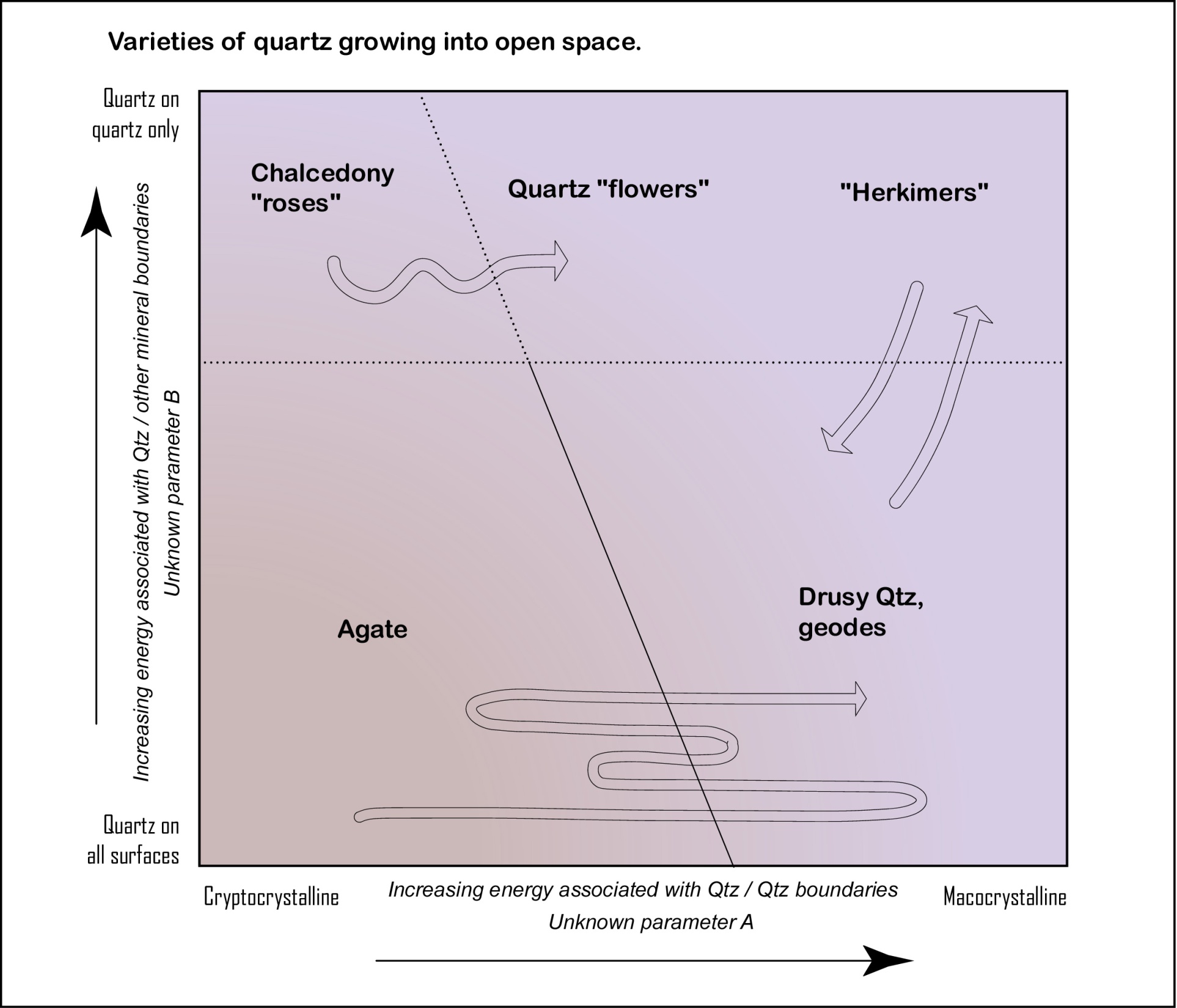
Where change from one variety to another is observed,
paths can be drawn.
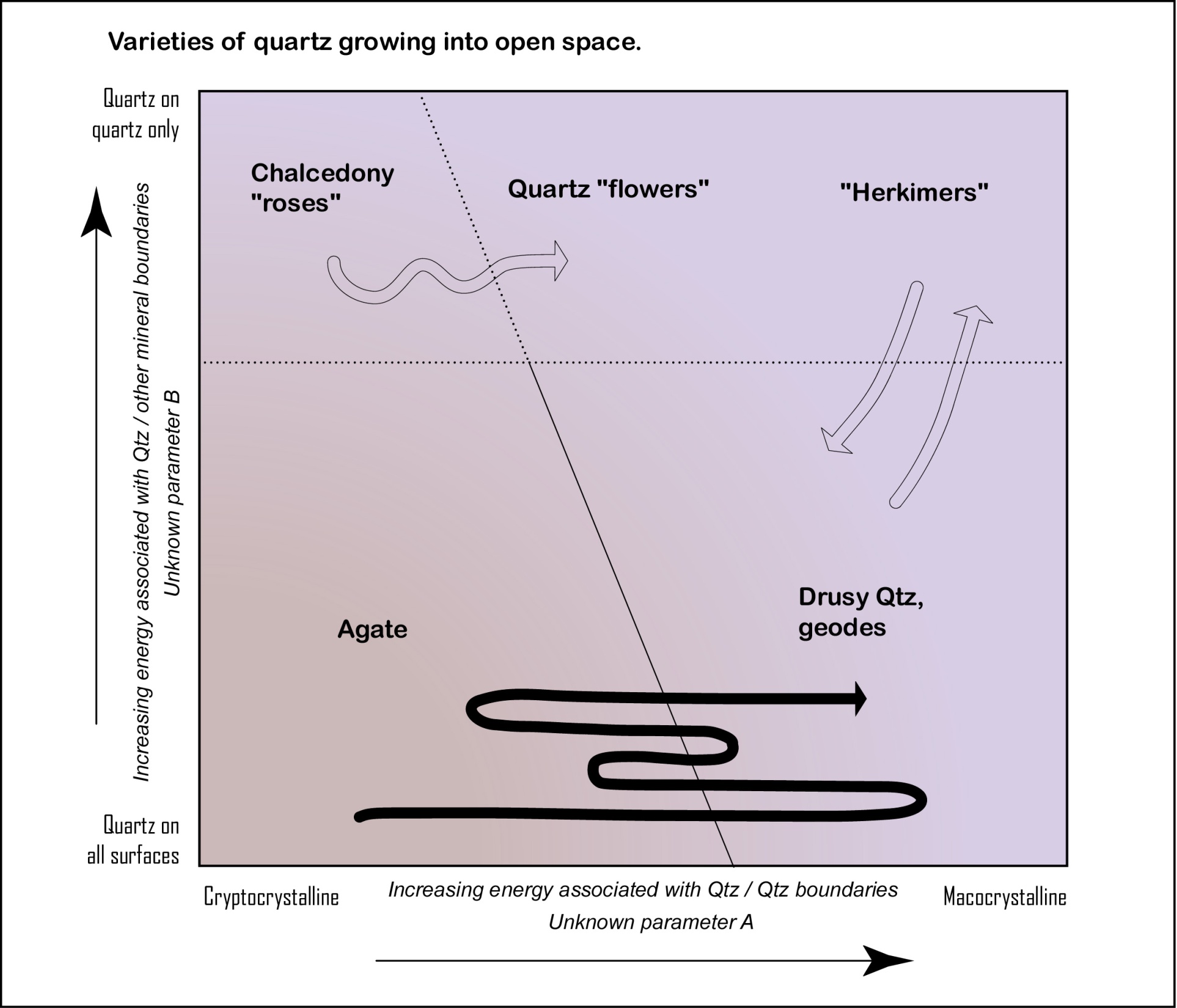
In many agate nodules, deposition goes back and forth
between drusy quartz and agate.
Brazilian agate comes as nodules that
formed in large vesicles in basaltic lavas from a number
of Brazilian states in southeastern region of the
country. Chalcedonic agate in shades of gray and tan are
most typical, but many show strong banding, often with
alternating chalcedony and druzy quartz.
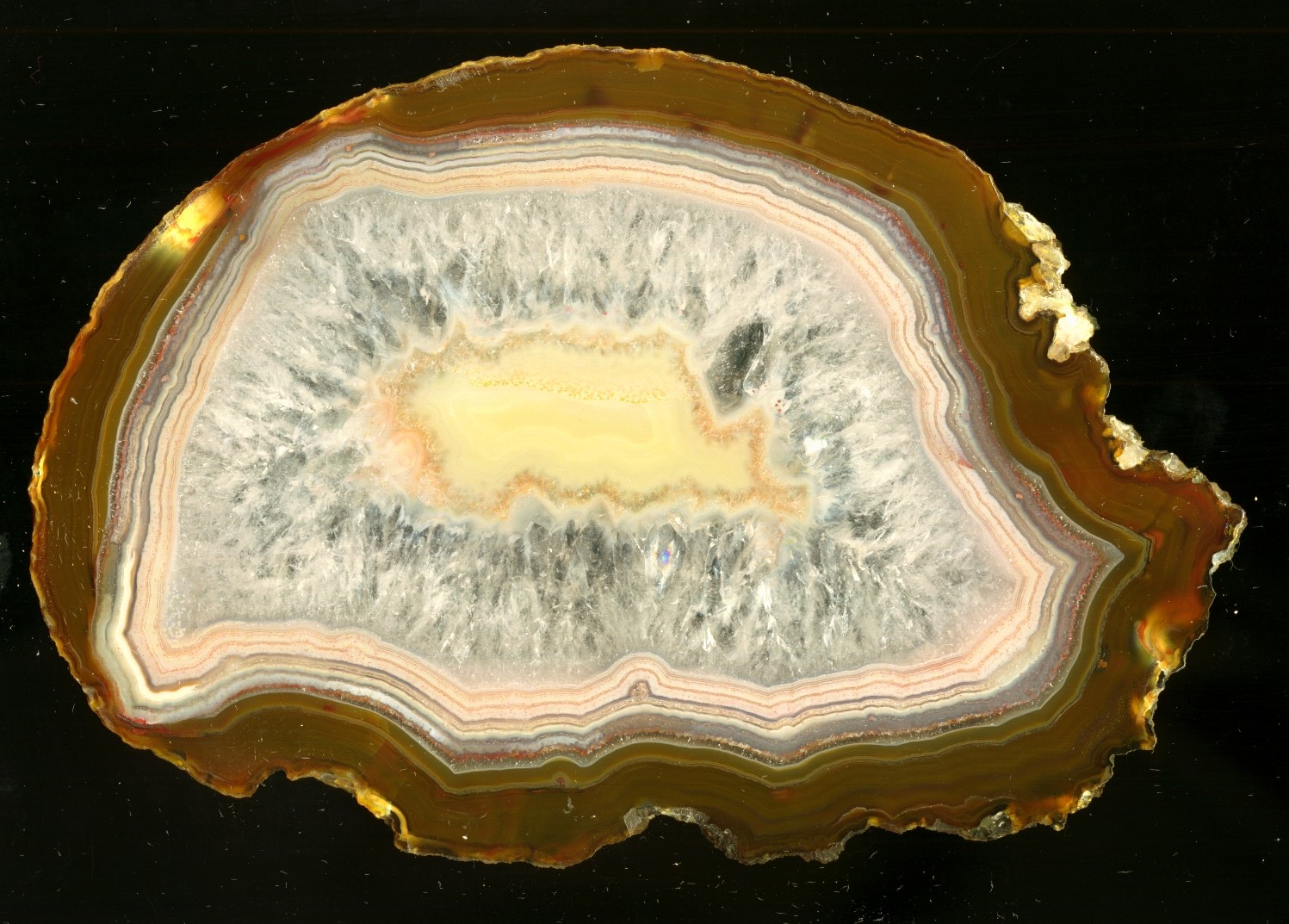
Brazilian nodule showing deposition alternating between
chalcedonic agate anddrusy quartz. These occur in
basaltic rock, but similar features are observed
elsewhere, including in Tennessee agates.
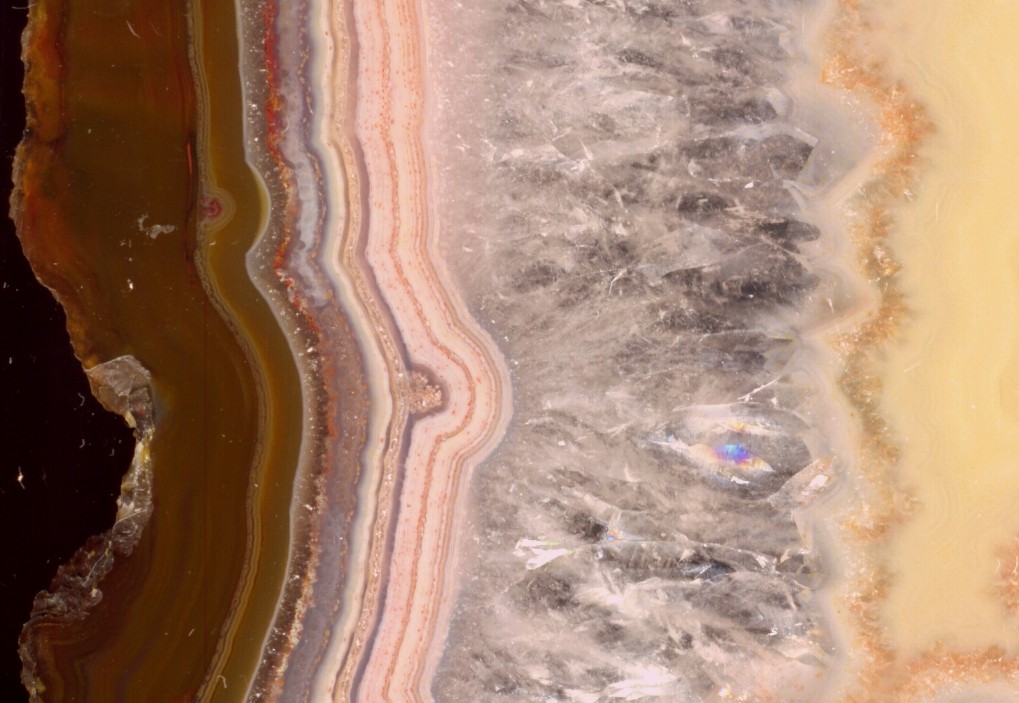
Detail of above. There are at least four distinct
layers of drusy quartz.
Tennessee
agate, from the lower part of the Mississippian age
Newman Limestone just above the contact with the Fort
Payne Chert near LaFollette, TN. Similar agate has been
seen in the quarries near Jellico. This agate resembles
the "Paint Rock" agate found near the Alabama
border, but tends to have many more cracks,


In thin section,it is seen to be a true (length-fast)
chalcedonic agate, (the bluish bands here) as revealed by
crossed polars and a quarter wave plate. The chalcedony
alternates with length-slow drusy quartz (yellowish
here). The chalcedony grew from lower right to upper left
in this arrangement, except for the chalcedony on the
very left end.
The
question of exactly what is changing to cause quartz
deposition to go from drusy to chalcedonic has never been
addressed. Since the morphology is so different, one
would expect it to be fairly extreme, but on the other
hand, it takes place deep underground where conditions
are pretty constant.
Transformations
most commonly occur to minimize the amount of energy in
the system. I would look for some factor affecting the
relative energy states of the crystals versus the
relatively disordered states of the crystal boundaries,
but have no idea what that factor might be.
In
contrast, the Summerville lace agate is
an occurrance of "agate" in a chert/gravel
quarry near Summerville, Georgia. It occurs in (or over)
the older Knox Group cherty dolomites, but may be much
younger than the surrounding country rock. There is no
unaltered carbonate bedrock exposed in the excavation.
All of it is granular length-slow drusy quartz, a form
sometimes referred to as "quartzine" or lace
agate. It lacks the flinty nature of true agate.

Summerville, georgia "agate". The sphere is
about 3 cm in diameter.

Thin section under low magnification, crossed polars.

detail, crossed polars

The same field as above, under rossed polars and a
quarter wave plate.
 . . . .
Close up under crossed polars. Note undulating extinction
(the shades of black, gray and white) on the edges of the
larger quartz crystals. And under ordinary light.
Interestingly, the banding continues as phantom lines
through relatively large quartz crystals. Right click and
open under new tab for enlarged views.
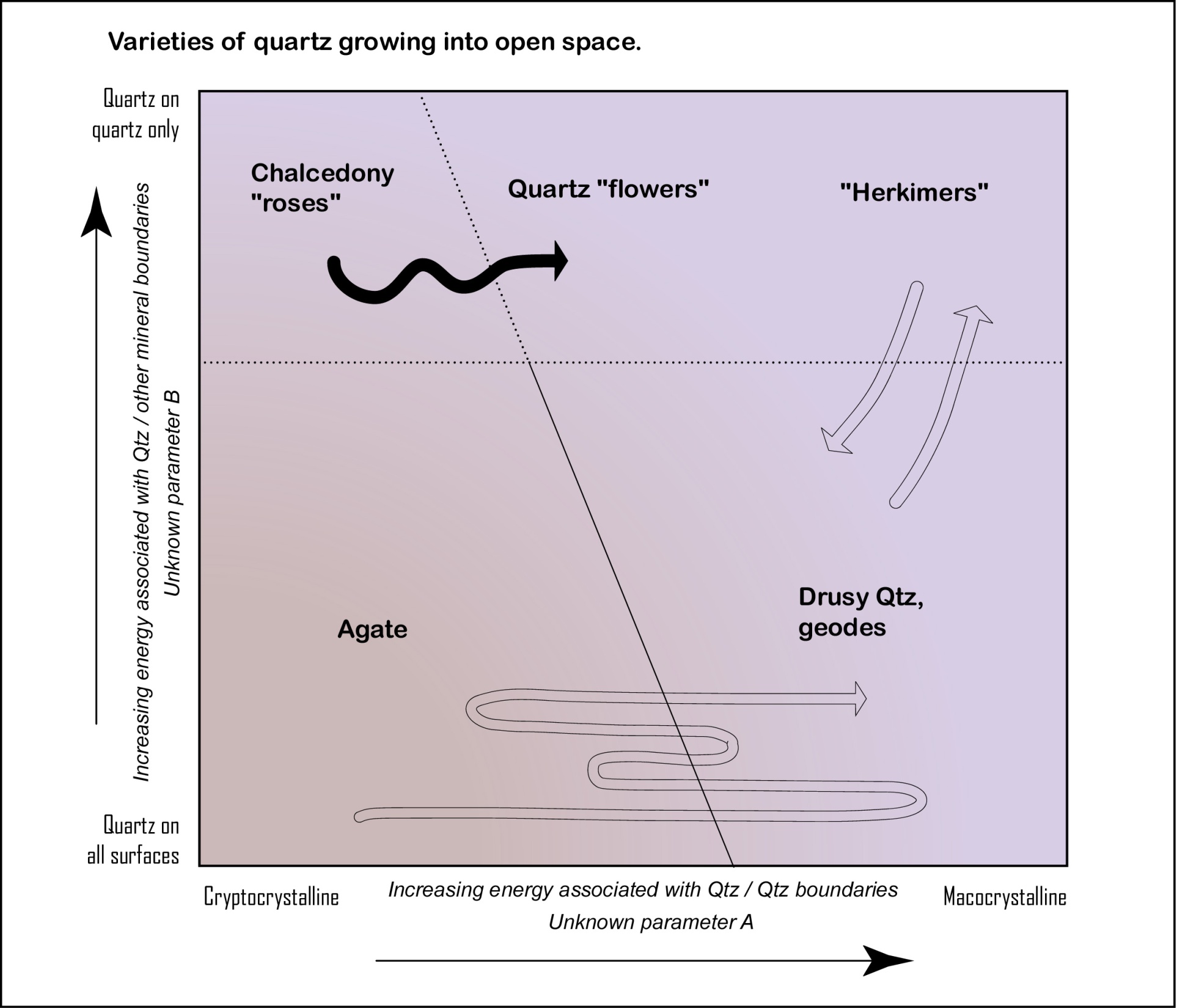
Quartz
flowers come from locations in Brazil and
elsewhere. For examples search for
“quartz flower” or “amethyst flower”
See Mindat, https://www.mindat.org/locentry-19482.html.
They are another example where quartz shows a preference
for depositing on existing quartz formations
One photo also had anhydrite, suggesting that the sulfate
ion may have a role in that. Another internet photo
showed a thunderegg with white chalcedony, overlying a
few quartz crystals on the wall, with a white quartz
flower in the center, again suggesting change from
chalcedonic to quartz-flower favoring conditions.
 . . 
Amethystine "quartz flower",
and attachment side with some of the celadonate from the
country rock wall. It demonstrates how the crystals grew
out from there without really making contact with the
surface
Not
found in the Eastern United States, chalcedony
roses occur in silicic volcanic rocks of the
West. These share in common with the
"Herkimers" and quartz flowers that quartz
avoids the country rock, and prefers existing quartz
formations.
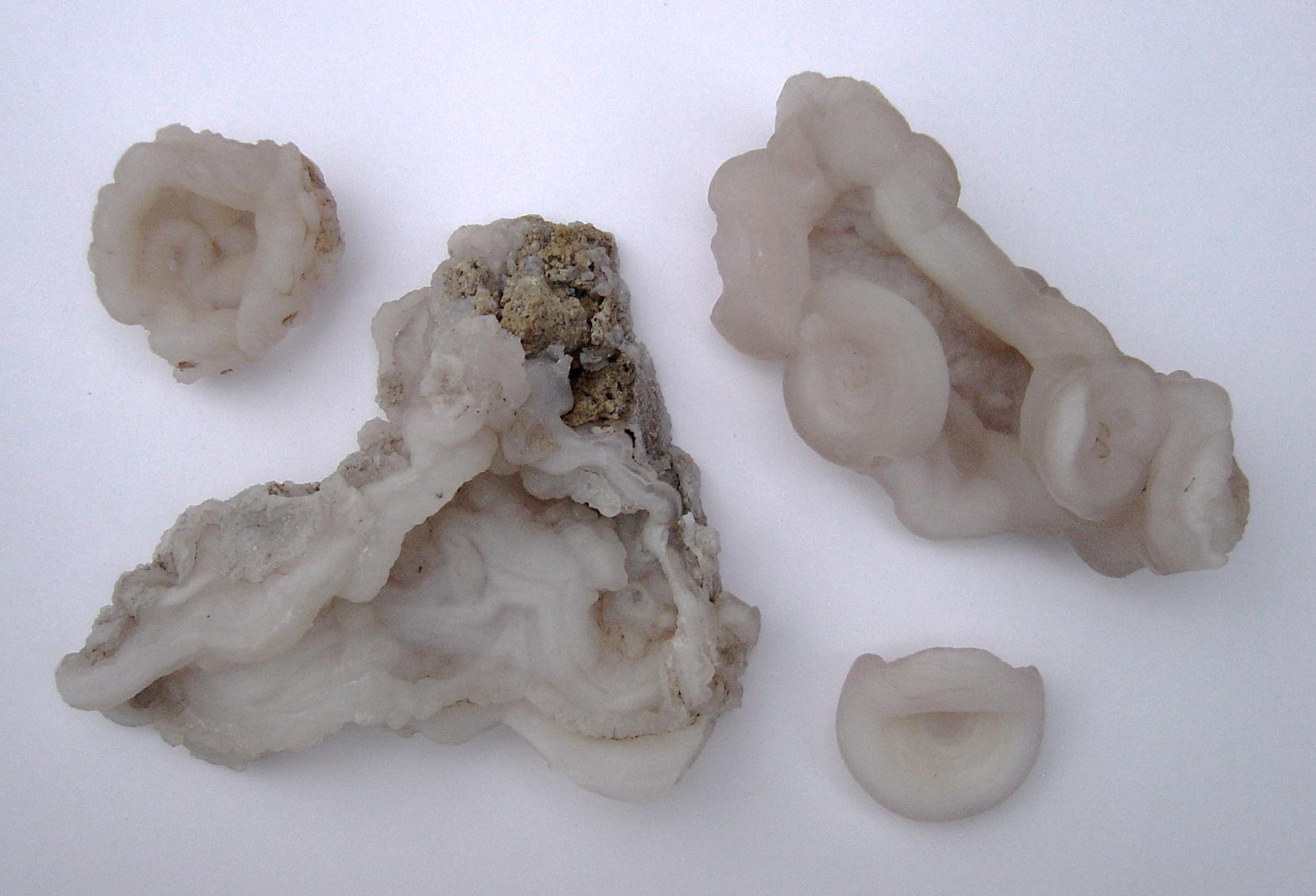
Examples of chalcedony roses, from Tertiary-age silicic
volcanic rocks in Clark County, Nevada.
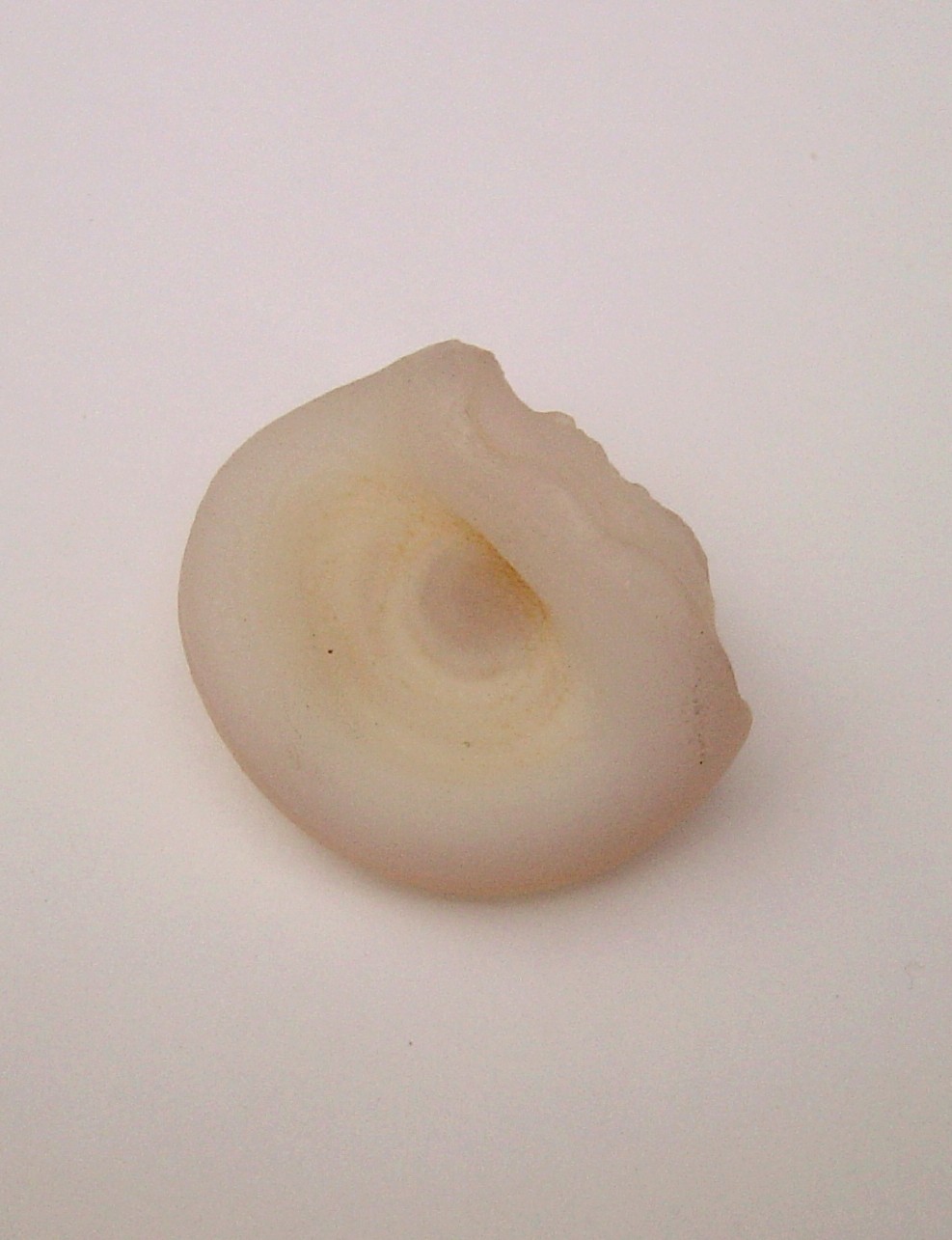 
Chalcedony roses can be simple buttons,…
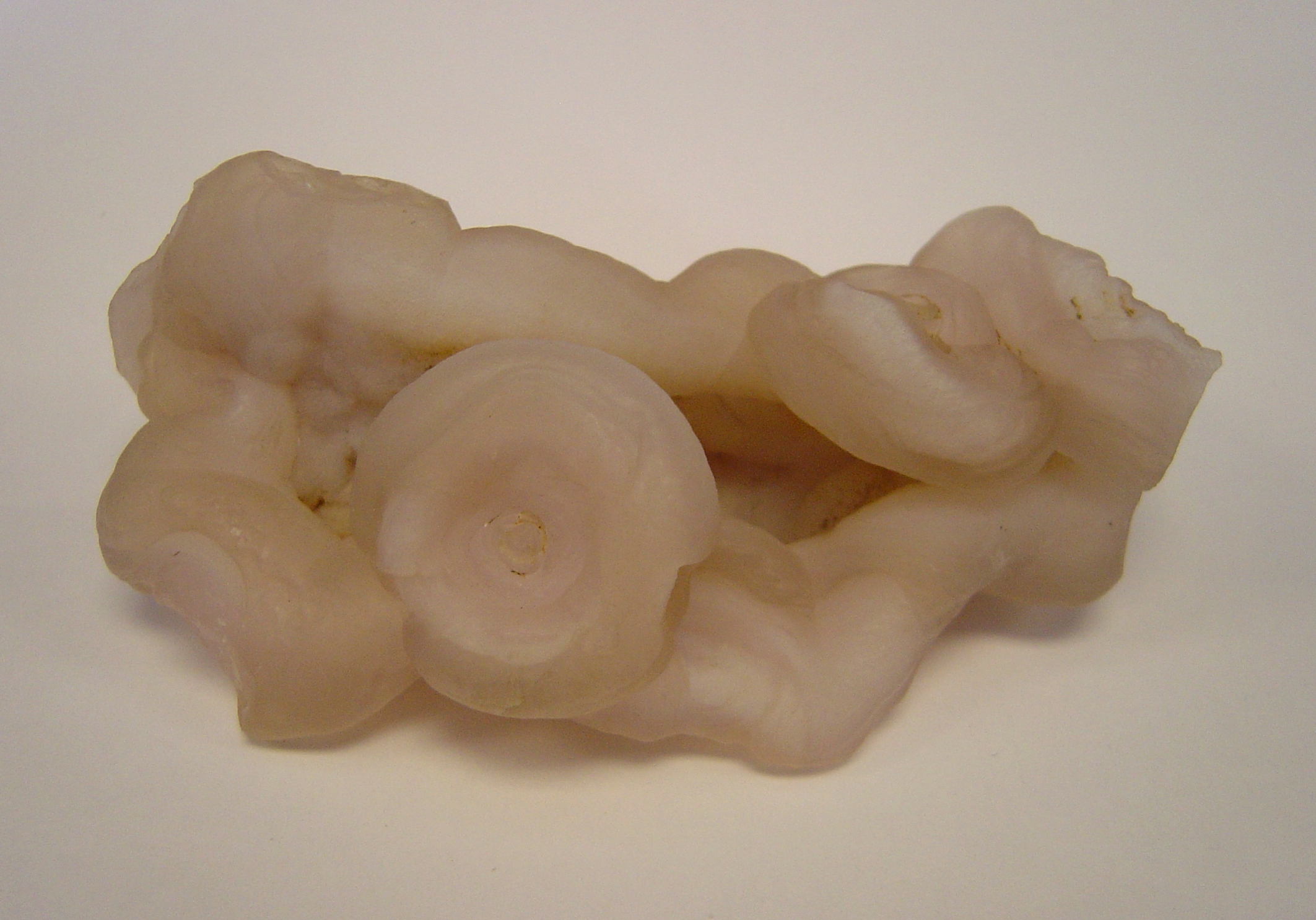
Or fused into more complex forms.
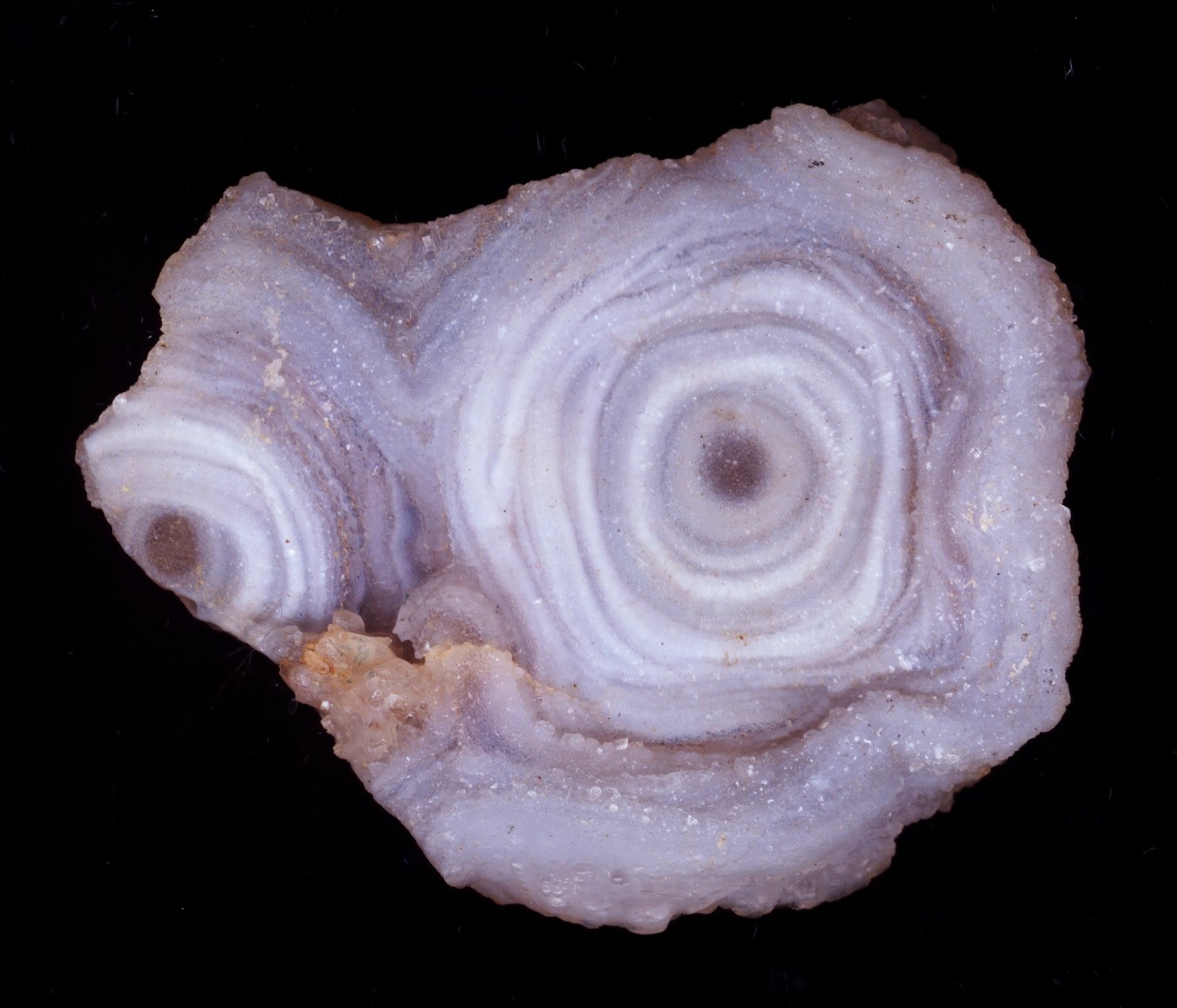
Chalcedony rose transitioning to crystalline growth.
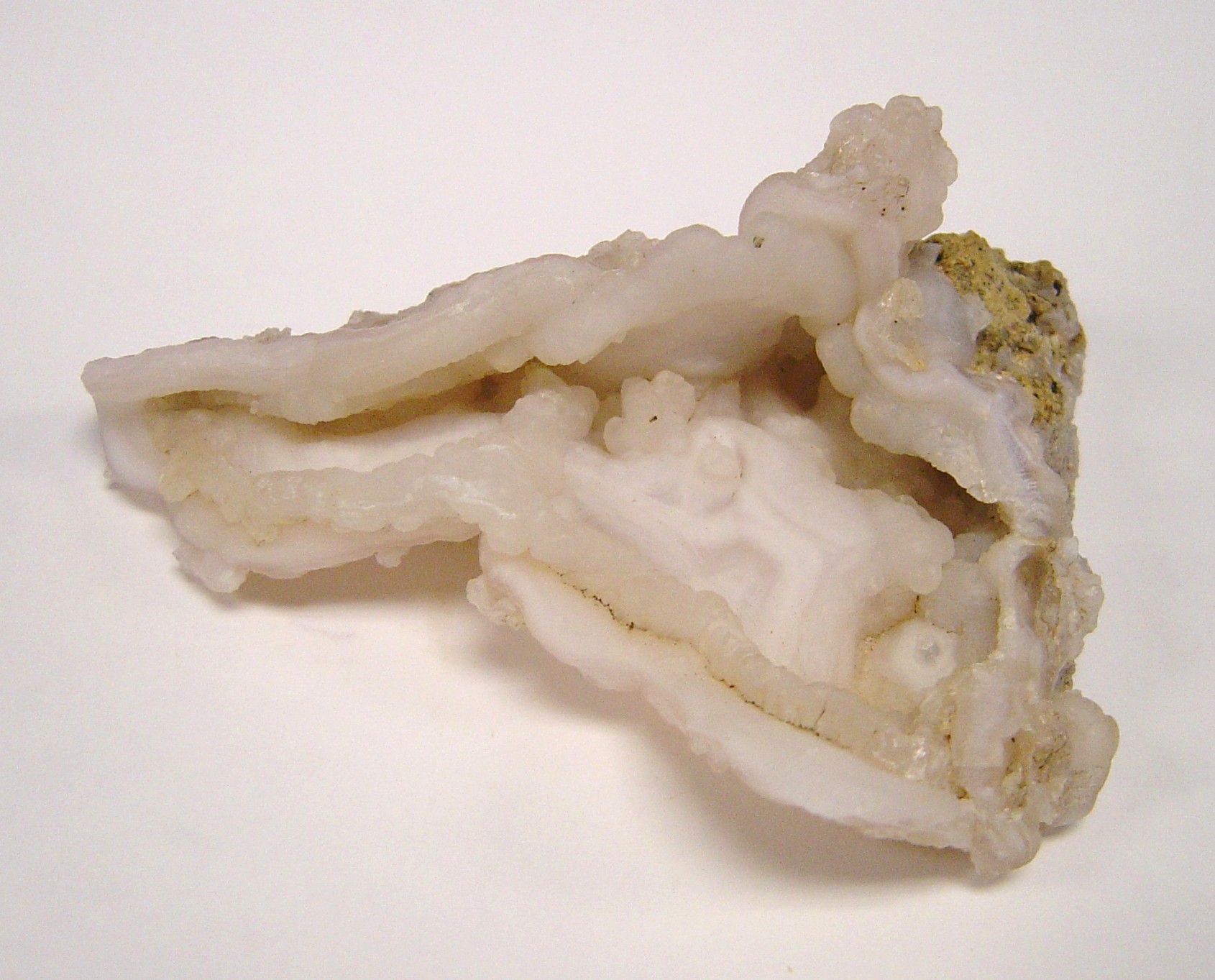
Another instance of fluctuating habit. This
specimen shows a line of chalcedony-covered quartz
crystals (slightly darker gray) growing along the lip.

Chalcedony rose in thin section under crossed polars. The
quartz is nearly transparent, and without the polarizing
filters you see almost nothing.

The quarter wave plate provides more information about
the optical orientation of the quartz.

Detail showing how the optical orientation of the
chalcedony can change from length-fast to length-slow
even within the same layers.

Further detail.
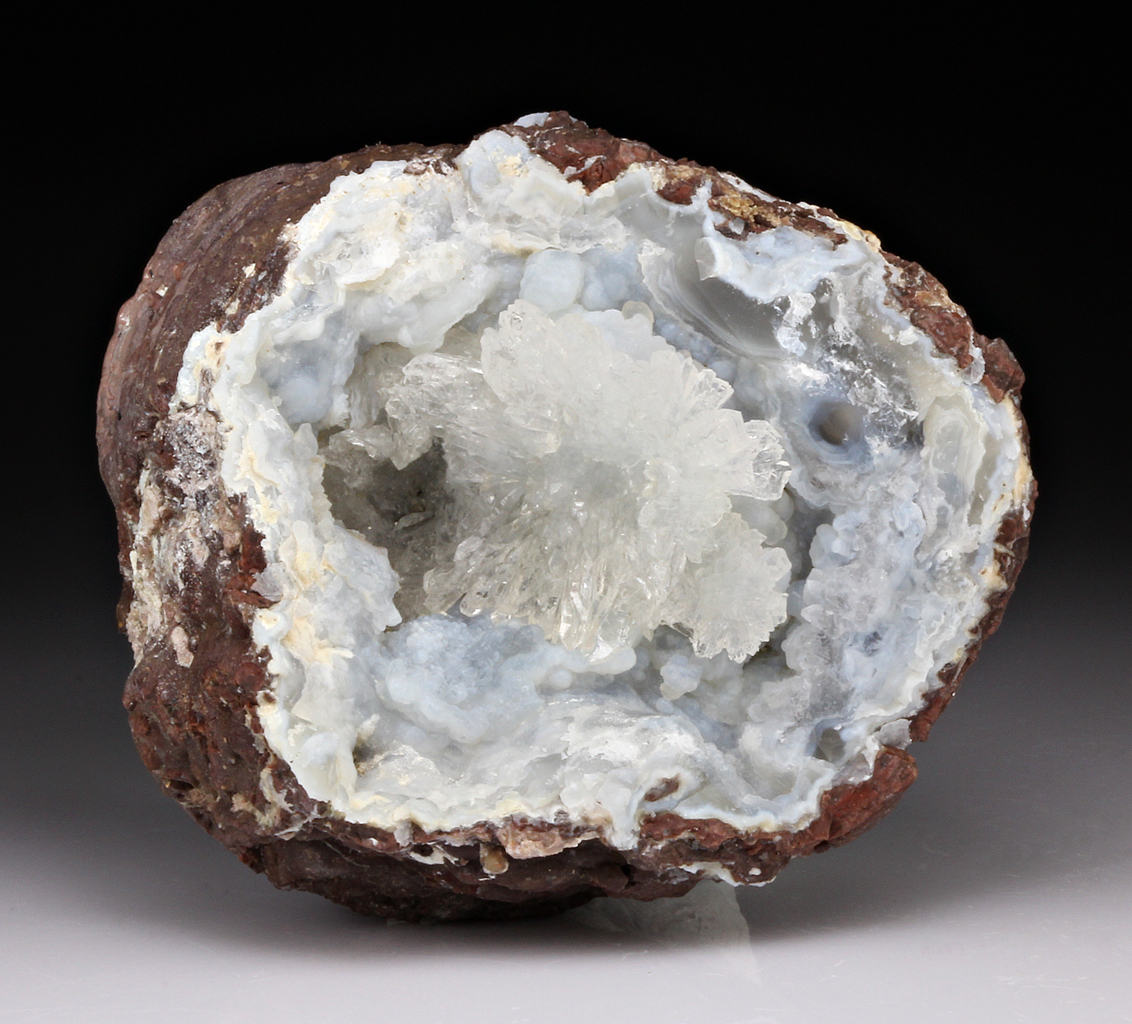
Internet photo, showing change from chalcedonic to
quartz-flower favoring conditions.
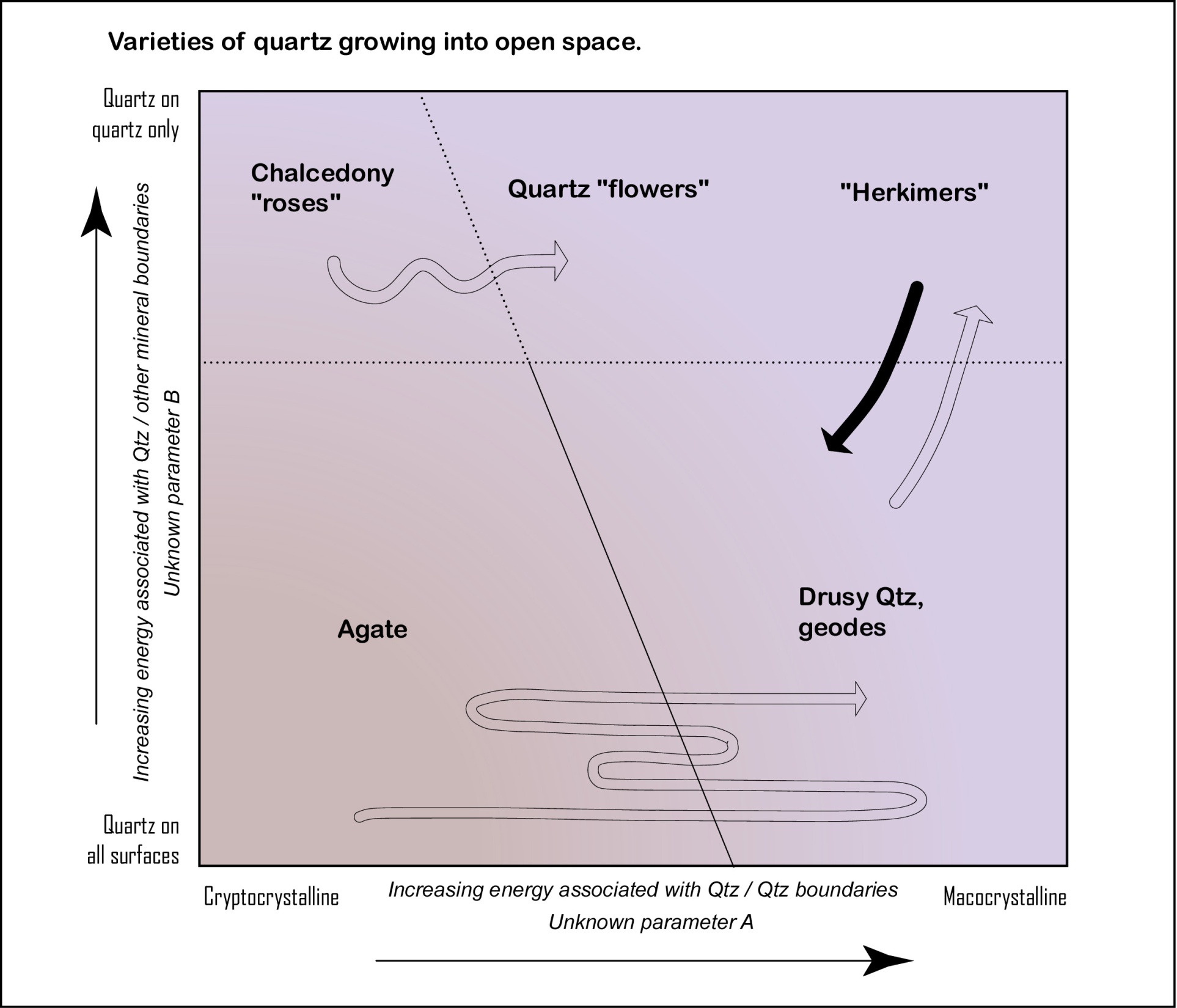
The so-called "cactus quartz" is a case where
larger quartz crystals become covered with finer drusy
crystals
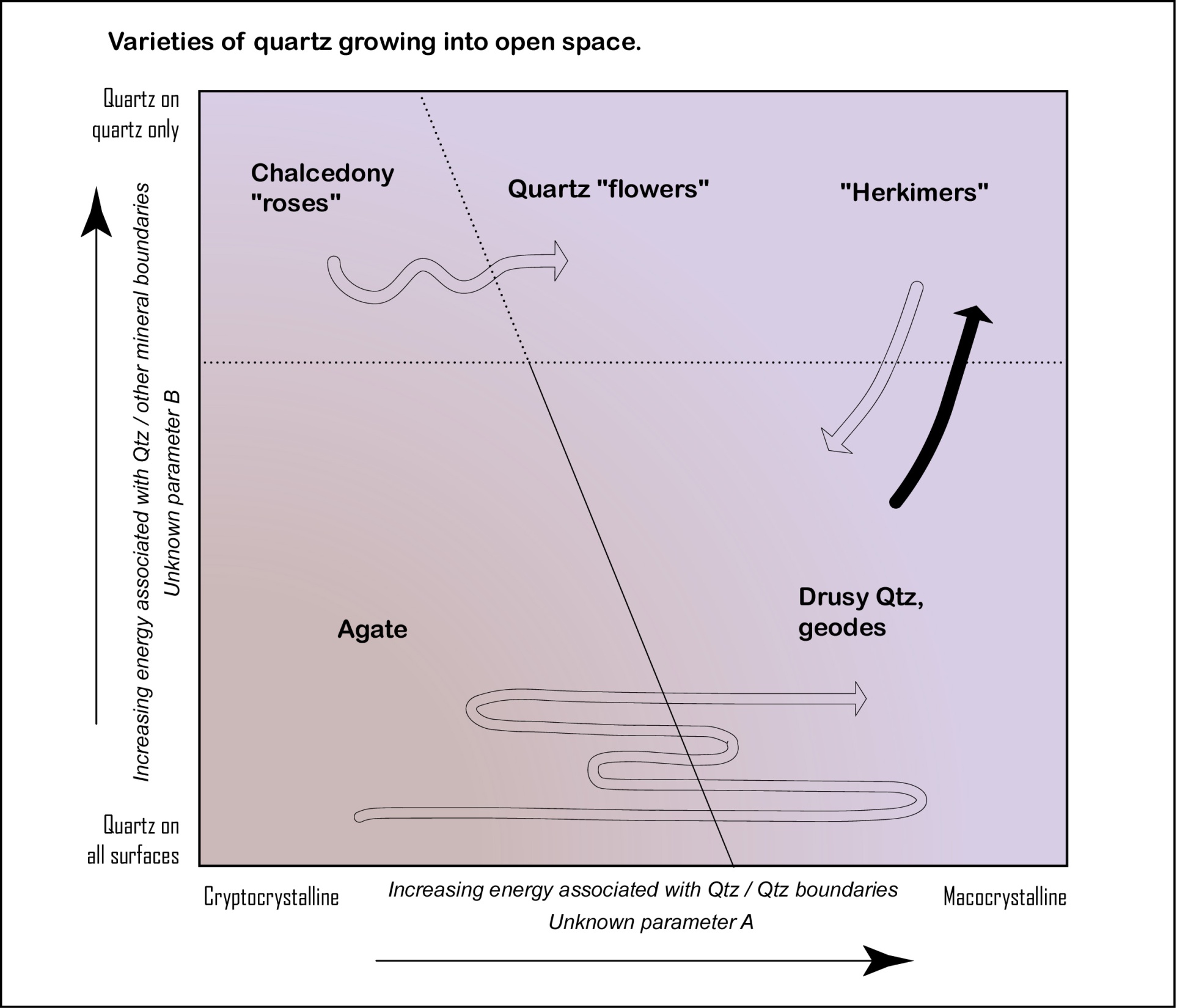
Conditions changing in the opposite direction yield some
of the most spectacular specimens. For example, large
late-stage amethyst growing upon white drusy crystals as
can be found in some amethyst occurrences. Photos were at
http://www.wilenskyminerals.com/about/criteria/ .
Nevertheless, the conditions responsible for these
changes remain elusive.
Index
Saltville.html
|











 . .
. . 










 . .
. .













